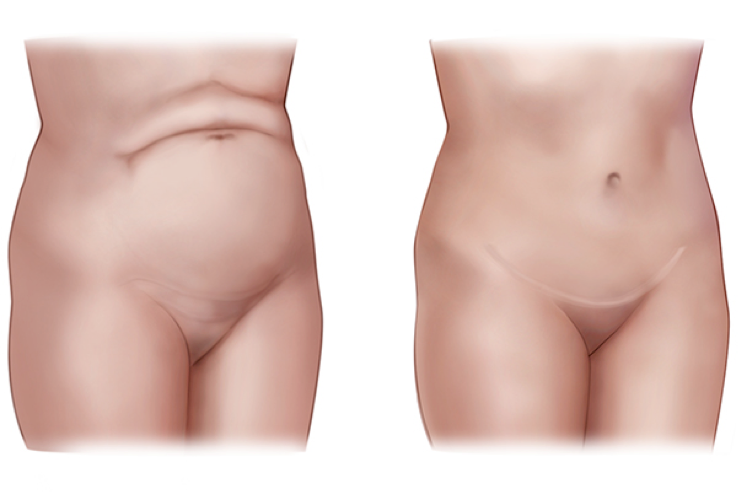A tummy tuck is a true game changer. It literally transforms people’s lives by restoring how they once felt about their body both in and out of clothes.

Abdominoplasty, commonly known as a tummy tuck, is performed to treat loose skin and fascia of the abdomen, which holds the underlying muscles in place. Many mistake extra skin and a bulging belly as “fat” when in fact it is the result of skin and the underlying fascia that have been hyperextended, and muscles that have separated beneath. Looseness of these tissues can commonly happen after pregnancies, but could also accompany significant weight loss.
After pregnancy, and particularly after multiple pregnancies, there is a major distension of the abdominal fascia. The fascia, connective tissue that holds the abdominal muscles tightly together, is not elastic in nature. In some women, it offers minimal “recoil,” resulting in a ballooned-out appearance. Even those dedicated to a fitness regimen ultimately discover that no exercise will correct this condition. Multiple tightening suture lines of the fascia/muscle layer must be done surgically, creating a permanent “internal girdle.” Abdominoplasty is a very effective method to flatten the tummy, narrow the waist and tighten loose skin. The most common adjunct procedure done is liposuction.
Priorities
The extent and type of procedure will be determined at consultation. Sometimes liposuction alone can contour the area sufficiently if the issue is just excess fat. Conversely, a tummy tuck alone, without liposuction might deliver the desired result if the issue is just loose fascia and skin. Proper diagnosis is key.
A full abdominoplasty involves both upper and lower parts of the abdomen. The scar is located horizontally across the lower abdomen. A mini tummy tuck is recommended when loose skin is limited to the lower part of the belly. This abbreviated procedure does not involve the umbilicus (belly button.) Scars are shorter and limited to the lower abdomen. Muscles of the lower belly can also be tightened in a mini tummy tuck if necessary.
Determining if liposuction should be done, how much and in what areas is done during the consultation. Timing is also part of the equation. Liposuction of the abdomen can be done safely and effectively at same time in most people. In cases where multiple areas or significant volumes of fat must be removed from the abdomen, it may be wiser to do a comprehensive liposuction procedure prior to a tummy tuck. This is not only a safer avenue, but actually provides for a better abdominoplasty result.
Hirmand Technique
I perform a “high lateral tension” abdominoplasty. Essentially, the excess skin is pulled down and inward and the tension is balanced and distributed along the entire length of the lower abdominal incision instead of being isolated in the central portion. This technique tightens the waist most effectively resulting in a narrower contour and better healing and quality of the scar. The fascial looseness is corrected with tightening suture line in the midline of abdomen and on the sides as needed.
This technique also includes meticulously closing skin in multiple levels. This reduces the risks of the scar “caving” in—eventually creating an obvious depression. It minimizes scarring, keeping incisions low and concealed. During a tummy tuck, there is also a focus on improving the shape and size of the belly button which is often dilated or changed during pregnancy. Improving belly button shape can be a happy byproduct of a tummy tuck.
New long lasting internal anesthetics and pain medicine catheters are used, as needed, to make the recovery more comfortable. This allows for early movement, and a shorter, more manageable recovery. Most return to their normal activities within 2-3 weeks.
Surgical Notes
Anesthesia: general
Length of surgery: 3-4 hours
Outpatient/inpatient: out patient
Adjunct procedures: Liposuction
Recovery: 2-3 weeks.